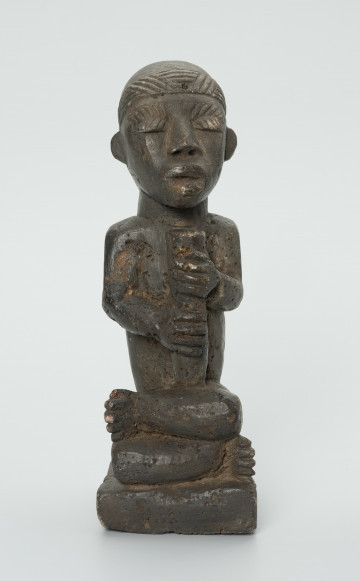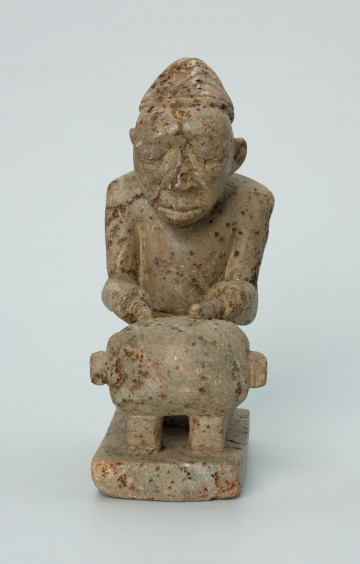
Ancestor worship figure
około 1901 — 2000
National Museum in Szczecin
Part of the collection: Mintadi figurines
The scene, sculpted in brown-grey stone, depicts a governor carried by four slaves on a lectern.The ntadi carving in question is related to the cult of ancestors and the cult of the dead in the Bakongo ethnic group. The name mintadi in the Kikongo language means guardians, custodians. Figures of mintadi were mainly found in cemeteries where high-rank chiefs were buried. They were also found in generally venerated places, such as on family altars. These stone sculptures are primarily symbolic portraits celebrating power. They were intended to present the permanence of the reign of the chiefs. Mintadi mainly depict the ruler or some of the dignitaries around him. Mfumu, the ruler, chief executive, is usually shown in a pose expressing meditation. Mfumu mpu, or local chief, performed religious and judicial functions in the Kingdom of Congo. Connected to the world of the ancestors, he maintained the link between the living descendants and the dead ancestors, who play an essential role in the lives of the former. The Bakongo believe that ancestors influence the fate of living people and are responsible for all fertility. The figure of a ruler in deep thought is also called fumani - a thinker. Apart from the ‘thinkers’, mintadi include images of women with children and representations of dignitaries and notables of lower ranks. The latter are usually depicted in a kneeling position, expressing submission and respect. Representations of rulers of higher rank, the so-called ‘royal’ mintadi can usually be recognised by the insignia of power, including a pipe, a staff, a cap and a necklace, and their majestic posture. Even though mintadi figures are not more than 60 centimetres high, the artist usually tried to highlight the monumentality, wisdom and power of the sculpted figure, a ruler full of reflection.
Katarzyna Findlik-Gawron
Author / creator
Dimensions
cały obiekt: height: 17,5 cm, width: 10,7 cm
Object type
sculpture
Creation time / dating
Creation / finding place
Identification number
Location / status

około 1901 — 2000
National Museum in Szczecin

około 1901 — 2000
National Museum in Szczecin

około 1901 — 2000
National Museum in Szczecin
DISCOVER this TOPIC
Museum of King Jan III's Palace at Wilanów
DISCOVER this PATH
Educational path